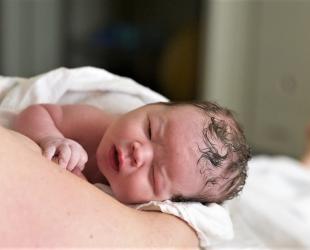Getting ready to breastfeed?
Here's what you can expect after the birth, a few weeks later and as time goes on.

Your timeline for breastfeeding really begins when you are young. For most of us, our exposure to breastfeeding within our family, our community and in the media influences how we think and feel about breastfeeding.
But for many women, it's not until you are pregnant that you really start to think about breastfeeding.
Here's an idea of what you and your partner can expect with breastfeeding from the arrival of your baby and as the months go on.

After the birth
Ask to have skin-to-skin contact with your baby as soon as possible after birth. If you need to be separated from your baby, ask that your baby has skin-to-skin contact with your partner.
You may feel some nipple discomfort which eases once baby is attached and feeding. If this doesn't improve or if you feel severe pain, or you have any signs of nipple damage, seek skilled help early.
Take note of what’s in your baby’s nappies. This is one way to tell if baby is getting enough breastmilk.

At home
Expect to spend lots of time sitting down, feeding your baby! It’s common for young babies to feed 8 to 14 times or more in 24 hours. You and your baby are working hard to get just the right amount of milk happening.
It can take 6 to 8 weeks for the breastfeeding 'dance' between mum and baby to find its rhythm. Each baby and mother pair is unique with different patterns, so try not to compare yourself or your baby to others.
There are usually lots of questions, from both parents, so your breastfeeding support network is very important at this time.
You can always come back here for information as you need it. Or consult your copy of Breastfeeding … naturally - free with your ABA membership!
Accept all offers of help from friends and family - you deserve it!
Going out
Going out with your breastfed baby is easy. You have baby's food ready to go at the right temperature in sustainable and attractive packaging (!) any time.
Have your nappy bag packed ready at the door. Nappies, wipes, perhaps a baby sling and a change of clothes are really all you need.
If bub is hungry while you are out, feel free to breastfeed anywhere. Be proud of what you and your baby can do.
Go to your local ABA get-togethers where you will meet mums with babies of the same age, with similar questions and experiences.

As time goes on
From around 6 weeks, many mums find they have lost that 'full' feeling in their breasts and start to question whether they have enough milk. What is actually happening is that your milk supply is starting to match the needs of your baby - clever you!
If you are concerned about your baby's weight gain, check this information on how to tell if your baby is getting enough milk.
Family foods can be introduced at around 6 months. The World Health Organization recommends that babies continue to receive breastmilk for 2 years, or more, as long as mother and child wish.
Returning to work - explore childcare options that are going to be compatible with your family needs and supportive of caring for a breastfed baby.
Celebrate your baby's many milestones, small and large. Above all, enjoy this special time!
© Australian Breastfeeding Association April 2022



